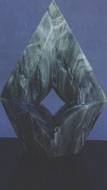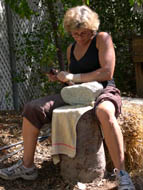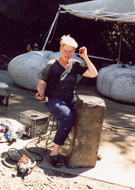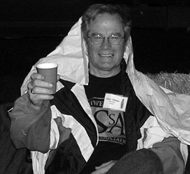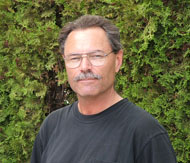Editor: We were sad to learn Dennis Joram passed away Friday, April 15th 2005, and just as this issue went to press. He was a talented and generous artist and will be missed by all who knew him. We sincerely regret he did not get to see this wonderful article. 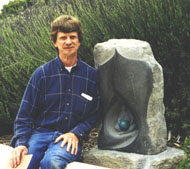
I just had to let fellow stone carvers know how much I enjoyed interviewing Dennis and meeting his wife, Bette and his son, Daniel.
When I arrived, Bette showed me some of Dennis’ sculpture in their home. It includes metal work, bronze, silver, gemstone, and stone. Dennis showed me several little bronze frogs sitting two together, courting, on jade lily pads. One frog sat by himself on a jade lily pad while Cupid stood on another lily pad aiming his bow and arrow at the lonesome frog. These were the delight of a number of people.
I got to look through Dennis’ portfolio during our interview. He pays attention to detail and design in each of his carvings. He’s a true craftsman.
I have never seen a more beautiful baby nursing at the mother’s breast in all of the art history I’ve read and contemporary sculpture that I have studied. I saw this piece at his home. It is a paper casting from a clay original and plaster mold.
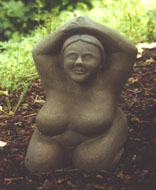
Dennis’ home and gardens are as lovely as his sculpture. He built his home and studio. In addition, he built a six-sided enclosed gazebo in which he cuts his stone. He also installed a terraced garden with two small spring-fed ponds.
After the interview, his son Daniel showed me his apartment which was Dennis’ studio. He and his dad finished it together, complete with granite tabletops and countertops. Dennis’ sculpture is there as well, including a series of small maquettes of lovely figures. He did these figures while attending a live model class. There is a life size torso that he made from a live model he cast in drystone.
Dennis shared that in the nine years during which he studied at the University of Washington, he drove a Metro bus for a living.
If you have been to the Seattle Center lately, and were tired and rested on a granite bench there, it was probably one of his creations. There are three such benches in the Peace Park of the Seattle Center.
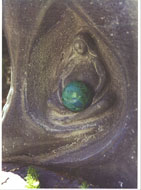
To see more of Dennis’s art work, see reachme@joramgalleries.
NG: We have missed you for the last few years. Where have you been?
DJ: I was thinking of ending the interview with this part, but I will start this way, and it will give a different understanding of what I am about to say. I haven’t been involved with the activities of the NWSSA in the last year and a half because I have multiple myeloma with peripheral neuropathy. (Multiple myeloma is a rare cancer of the bone marrow cells that make immunoglobulin. It is related to leukemia, but not the same thing. Peripheral neuropathy is damage to the peripheral nerves, which are those outside of the brain and spinal cord.) In my case the first symptoms of the cancer began with damage to the nerves of my hands and arms, and pain in my shoulders. I don’t have much use of my hands, and now, as a result of the cancer combined with the chemotherapy, the rest of my body has become very weak. I also can’t be around groups because I have no immunity right now to everyday germs.
The last sculpture I did was a year ago. It is my hope that my cancer will go into remission and then I will be able to rejoin the group at some time in the future.
NG: What has the NWSSA meant to you?
DJ: I started my first symposium in 1990 and have attended most of the Camp Brotherhood symposia since. The instruction, comradeship, acceptance and affirmation of the group have basically given me my art over that time. Now that I can’t produce art, sitting up until 2 o’clock in the morning talking with artists and sharing ideas and stories has become even more memorable. I have had the opportunity over the years to share one-on-one at each symposium and those moments will always be with me.
NG: What has been your artistic training?
DJ: I attended the University of Washington for nine years, taking five credits per quarter, to complete a BFA in Sculpture. There, I saw a poster about the NWSSA and Camp Brotherhood on the foundry wall in 1990. I joined the organization and have gone to Camp Brotherhood almost every summer since 1990. I have been with the NWSSA for 15 years.
I wasn’t taught stone carving at the University of Washington. The NWSSA filled that material void. I learned to love stone, and that is my primary material now.
NG: Which sculptures that you have produced are your favorites and why?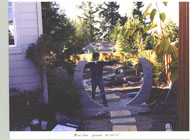
DJ: One was “Yoga Moon.” It was started at a Whidbey Island symposium and completed by the following symposium. I found a piece of alabaster at Whidbey Island that lent itself beautifully to the theme of a full moon. I was carrying the maquette of a female figure doing a yoga stretch and didn’t know what to do with her. She became “Yoga Moon.” The stone decided for me.
“Moon Gate” was fabricated at Camp Brotherhood and assembled in the client’s garden. The pieces are granite and it is built in a standing circle. It was influenced by my love of Japanese art, and for me, it is symbolic of the full moon... The inside is smooth and round because the eye is drawn to the middle of the gate. The outside is a pitched edge, much rougher. There is more freedom of texture on the outside edge. It stands about 6’ tall.
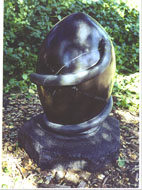
NG: What type of art do you do?
DJ: My art originates from outside myself, outside inspiration, rather than inside myself. Within my body of art I cross over between figurative, abstract and functional. It is not that each piece is all of those, but I would do a granite countertop as a well as a piece of fine art because that was what people wanted in stone. I am not caught up in the polarization between fine art and craft. To me it doesn’t make any difference what material I’m working in to complete an idea—it could be bronze, it could be anything, but I chose stone as my main material.
NG: What is your philosophy of carving?
DJ: I believe that the craft part of art should be of the highest quality we can produce because it brings out the richness of whatever materials we are using, and the flaws do not become a distraction to the viewer.
NG: What are your future goals for your art?
DJ: Even though I can no longer carve, I had my son place a favorite piece of Alaskan marble on my carving table. I am able to draw inspiration from it with the goal of someday working in stone again. And if that never happens, nature has carved on the stone for centuries. In its present state the stone is a piece of art in itself.